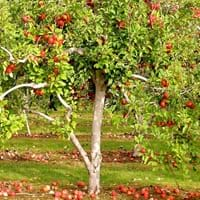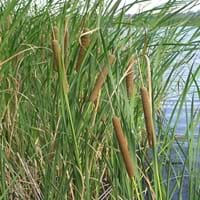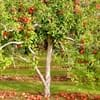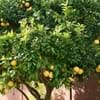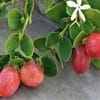Life Span
Perennial
Perennial
Type
Flowering Plants, Fruits, Trees
Aquatics
Origin
Central Asia
North America, United States, Northeastern United States, Mid-Atlantic United States, Southeastern United States, North-Central United States, Central United States, Western United States, California, Canada
Types
Aceymac apple, Bailey Sweet apple, Dabinett apple, Nehou apple
Not Available
Number of Varieties
Not Available
Habitat
Hillside
Bog Garden, Ponds
USDA Hardiness Zone
5-8
3-10
Sunset Zone
A1, A2, A3, 8, 9, 10, 11, 12, 13, 14, 15, 16, 17, 18, 19, 20, 21, 22, 23, 24
21,22
Habit
Oval or Rounded
Thicket/Colonizing
Flower Color
White
Light Yellow, Light Green
Flower Color Modifier
Not Available
Not Available
Fruit Color
Green, Red
Brown
Leaf Color in Spring
Dark Green
Green
Leaf Color in Summer
Green
Green
Leaf Color in Fall
Brown, Green, Light Yellow
Green
Leaf Color in Winter
Not Available
Not Available
Leaf Shape
Oblong
Flat, Narrow
Plant Season
Spring
Summer, Fall
Sunlight
Full Sun, Partial shade
Full Sun, Partial Sun
Type of Soil
Loamy
Loam, Sand
The pH of Soil
Neutral
Acidic, Neutral, Alkaline
Soil Drainage
Well drained
Poorly Drained
Bloom Time
Fall, Summer
Early Summer, Summer
Tolerances
Drought
Wet Site
Where to Plant?
Ground
Ground
How to Plant?
Grafting, Seedlings, Transplanting
Divison, Seedlings
Plant Maintenance
Medium
Medium
Watering Requirements
Medium
Needs Very high moisture
In Summer
Lots of watering
Lots of watering
In Spring
Moderate
Moderate
In Winter
Average Water
Average Water
Soil pH
Neutral
Acidic, Neutral, Alkaline
Soil Type
Loamy
Loam, Sand
Soil Drainage Capacity
Well drained
Poorly Drained
Sun Exposure
Full Sun, Partial shade
Full Sun, Partial Sun
Pruning
Prune when plant is dormant, Remove dead or diseased plant parts
Remove damaged leaves
Fertilizers
All-Purpose Liquid Fertilizer
Nutrient Rich Fertilizer
Pests and Diseases
Aphids, Canker, Caterpillars, Powdery mildew, Root rot
Free of serious pests and diseases
Plant Tolerance
Drought
Drought
Flower Petal Number
Single
Not Available
Foliage Texture
Medium
Coarse
Foliage Sheen
Matte
Glossy
Allergy
Mouth itching, Throat itching
Mild Allergen
Aesthetic Uses
Not Used For Aesthetic Purpose
Cut Flowers, Wild gardens
Beauty Benefits
Not Available
Not Available
Environmental Uses
Air purification
Air purification
Medicinal Uses
Cancer, constipation, Diabetes, Diarrhea, Dysentry, Fever, Heart problems, Tooth ache
anticoagulant, Diuretic, Haemostatic, Miscellany
Part of Plant Used
Fruits
Flowers, Leaves, Root, Seeds, Stem
Other Uses
Used As Food, Wood is used for making furniture
Used as a thickener in soups, Used to make biscuits, Used to produce edible oil, Used to yield a sweet syrup
Used As Indoor Plant
No
No
Used As Outdoor Plant
Yes
Yes
Garden Design
Fruit / Fruit Tree, Shade Trees, Showy Tree
Dried Flower/Everlasting, Wildflower
Botanical Name
Malus domestica
TYPHA angustifolia
Common Name
Apple Tree
Narrowleaf Cattail, Lesser Reedmace
In Hindi
सेब का वृक्ष
Narrowleaf Cattail
In German
Apfelbaum
Schmalblättriger Cattail
In French
Pommier
Narrowleaf Cattail
In Spanish
Manzano
Espadaña de hoja estrecha
In Greek
μηλιά
στενόφυλλα Cattail
In Portuguese
Macieira
Narrowleaf Tifa
In Polish
jabłoń
Wąskolistne Cattail
In Latin
Arbore
Cattail glaucescens
Phylum
Magnoliophyta
Magnoliophyta
Class
Magnoliopsida
Liliopsida
Family
Rosaceae
Typhaceae
Clade
Angiosperms, Eudicots, Rosids
Angiosperms, Commelinids, Monocots
Tribe
Not Available
Not Available
Subfamily
Not Available
Not Available
Number of Species
Not Available
Not Available
Importance of Apple Tree and Narrowleaf Cattail
Want to have the most appropriate plant for your garden? You might want to know the importance of Apple Tree and Narrowleaf Cattail. Basically, these two plants vary in many aspects. Compare Apple Tree and Narrowleaf Cattail as they differ in many characteristics such as their life, care, benefits, facts, etc. Every gardener must at least have the slightest clue about the plants he wants to plant in his garden. Compare their benefits, which differ in many ways like facts and uses. The medicinal use of Apple Tree is Cancer, constipation, Diabetes, Diarrhea, Dysentry, Fever, Heart problems and Tooth ache whereas of Narrowleaf Cattail is anticoagulant, Diuretic, Haemostatic and Miscellany. Apple Tree has beauty benefits as follows: Not Available while Narrowleaf Cattail has beauty benefits as follows: Not Available.
Compare Facts of Apple Tree vs Narrowleaf Cattail
How to choose the best garden plant for your garden depending upon its facts? Here garden plant comparison will help you to solve this query. Compare the facts of Apple Tree vs Narrowleaf Cattail and know which one to choose. As garden plants have benefits and other uses, allergy is also a major drawback of plants for some people. Allergic reactions of Apple Tree are Mouth itching and Throat itching whereas of Narrowleaf Cattail have Mild Allergen respectively. Having a fruit bearing plant in your garden can be a plus point of your garden. Apple Tree has showy fruits and Narrowleaf Cattail has showy fruits. Also Apple Tree is flowering and Narrowleaf Cattail is not flowering . You can compare Apple Tree and Narrowleaf Cattail facts and facts of other plants too.
